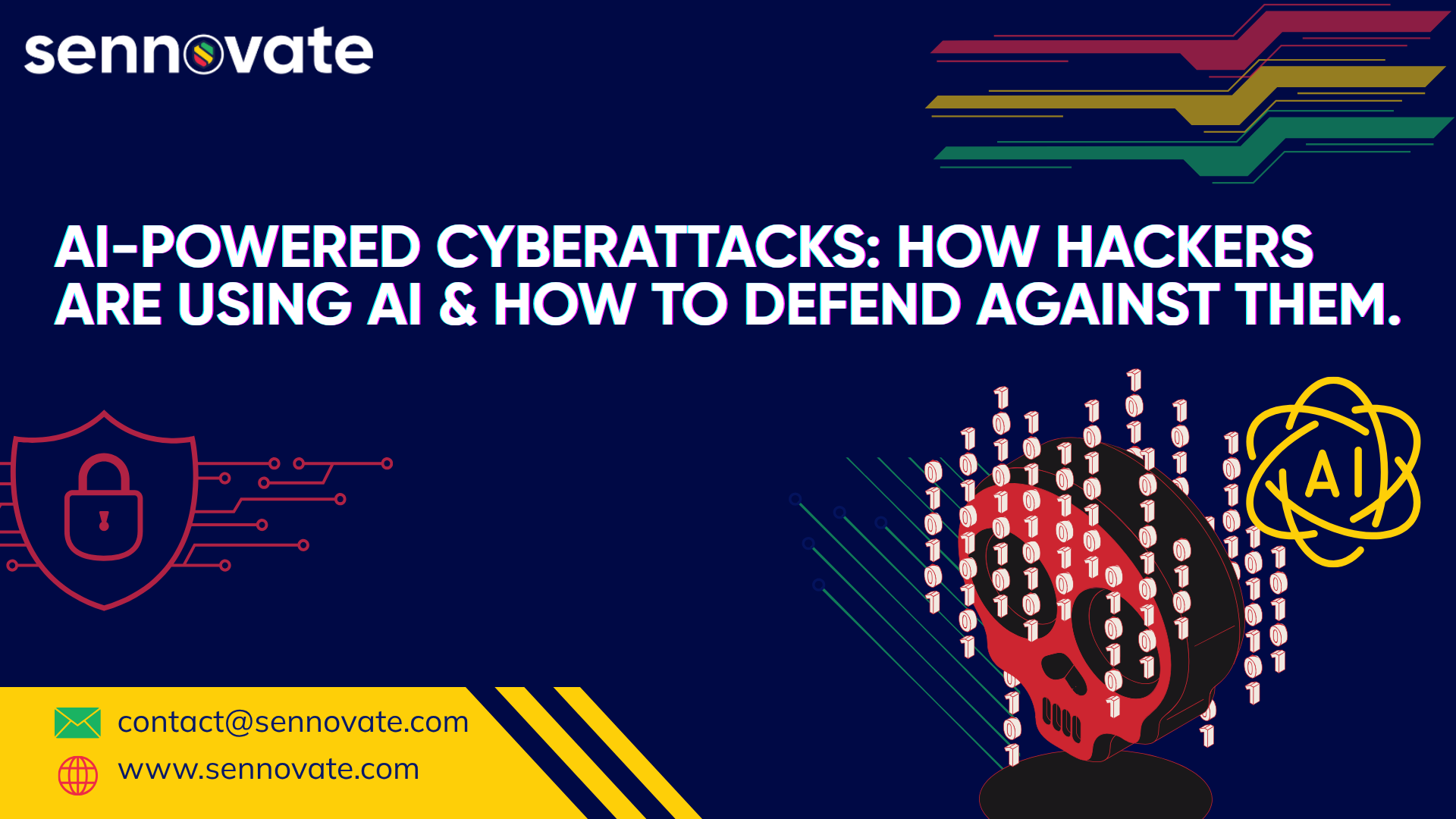- Services
-
-
Strike Team & SSSP
- Strike Team
- Sennovate Security Starter Pack (SSSP)
-
- Media
- Careers
- Contact Us


AI-Powered Cyberattacks: How Hackers Are Using AI & How to Defend Against Them.
Artificial Intelligence (AI) is transforming various sectors, including the realm of cybercrime. While companies are leveraging AI to bolster their security measures, cybercriminals are utilizing it to execute more sophisticated, rapid, and elusive attacks. By 2025, it is anticipated that AI-driven cyber threats will escalate, rendering conventional security protocols ineffective. For organizations across the United States and globally, comprehending these threats is essential. This blog delves into the methods employed by cybercriminals to exploit AI, provides real-world case studies, and offers practical strategies for defense, featuring insights from Sennovate, a prominent cybersecurity service provider in the USA.
The Use of AI by Hackers in Cyberattacks
1. AI-Powered Social Engineering & Phishing
Phishing emails are now difficult to identify. These days, hackers create incredibly convincing messages using natural language processing (NLP) driven by AI.
- Deepfake Emails and Voice Cloning: AI imitates the writing or speech patterns of executives to deceive staff into sending money.
- Dynamic Content Generation: Phishing emails are tailored by attackers using social media or LinkedIn data that has been scraped.
- Automated Spear Phishing: AI finds valuable targets and sends malicious links that are specifically tailored to them.
- Real-World Example: In 2024, an AI-generated CEO fraud scheme cost a US-based financial company $2.5 million.
2. AI-Driven Malware & Evasion Techniques
Traditional antivirus software relies on signature-based detection. AI-powered malware adapts in real time to bypass defenses.
- Polymorphic Malware: Changes its code structure to avoid detection.
- AI-Enhanced Ransomware: Learns network behaviors to maximize damage before encryption.
- Autonomous Botnets: Self-propagating botnets (like Mirai 2.0) target IoT devices at scale.
📌 Case Study: A 2024 healthcare breach involved AI malware that evaded EDR solutions for weeks before detection.
3. AI-Powered Credential Stuffing & Password Cracking
AI has made brute-force attacks 100 times faster.
- Attacks Guided by Neural Networks: AI uses compromised databases to forecast password patterns.
- Credential Stuffing Automation: AI instantly tests millions of credentials that have been stolen from various websites.
- Biometric Spoofing: Facial scans or fingerprints produced by AI get around authentication.
📌 According to Verizon’s 2024 DBIR, 81% of hacking-related breaches involve compromised or weak passwords.
4. Vulnerability Exploitation Driven by AI
AI is used by hackers to search networks, find vulnerabilities, and quickly take advantage of them.
- Automated Zero-Day Exploits: Before vendors address unpatched vulnerabilities, AI finds them.
- AI-Powered Penetration Testing (But Malevolent): Cybercriminals imitate ethical hacking, but for illicit purposes.
- For instance, in 2024, an AI program called “DeepExploit” broke into business networks on its own in a matter of minutes.
5. Deepfake Attacks & AI-Enhanced Disinformation
AI is employed for psychological manipulation in addition to data theft.
- Amplification of Fake News: AI bots disseminate false information to influence elections or stock prices.
- Deepfake Blackmail: Extortion is done using fake audio and video.
- Fake identities created by AI are utilised in business email compromise (BEC) scams.
📌 Recent Incident: In 2024, artificial intelligence-generated phoney endorsements were used to target a US political campaign.
How Can AI-Powered Cyberattacks Be Prevented?
1. Implement threat detection based on AI
Use AI to combat AI:
✔ AI-Powered SIEM & XDR: Identifies irregularities instantly.
✔ Behavioural Analytics: Identifies anomalous user behaviour.
✔ Automated Incident Response: SOCs with AI capabilities, such as Sennovate’s MDR services, react immediately.
2. Make Identity & Access Management (IAM) stronger
✔ Zero Trust Architecture: “Never trust, always verify.”
✔ Biometric + AI-Based Authentication: Identifies attempts at spoofing.
✔ Constant Passwordless MFA: Reduces the risk of credential theft.
3. Educate Staff on AI-Powered Social Engineering
Deepfake phishing is simulated by AI-Enhanced Security Awareness Programs.
✔ Red Team Exercises: Evaluate how staff members react to scams created by AI.
4. Use Vulnerability Management Driven by AI
✔ Automated Patch Management: AI gives priority to important fixes.
✔ AI-Based Penetration Testing: Identifies vulnerabilities before hackers do.
5. Collaborate with an AI-Aware MSSP (such as Sennovate)
✔ AI-Powered Threat Hunting Around-the-Clock
✔ AI Attack-Resistant Quantum-Resistant Encryption
✔ AI Security Frameworks That Are Compliance-Ready
Conclusion: Prevent AI-Related Cyberthreats in 2025
AI has two sides: it gives cybercriminals more power while simultaneously providing next-generation defences. Companies both domestically and internationally need to: ✅ Implement AI-powered cybersecurity solutions
✅ Educate staff on AI-driven risks
✅ Collaborate with specialists like Sennovate for preventative defence
📞 Do You Need AI-Ready Cybersecurity? For a free security evaluation, get in touch with Sennovate right now!
